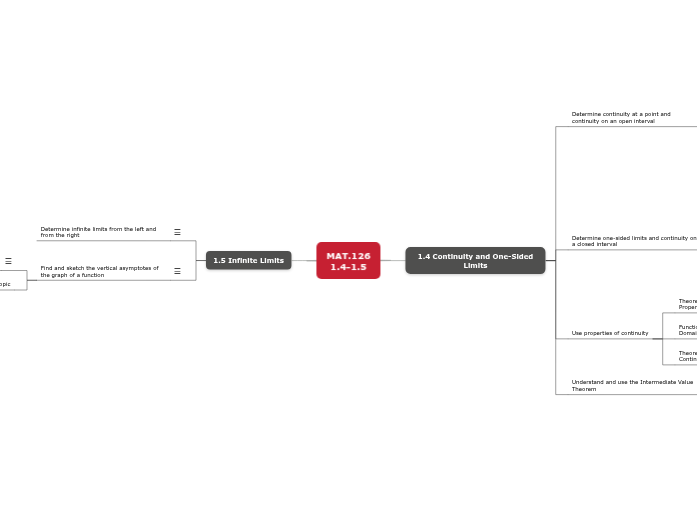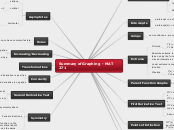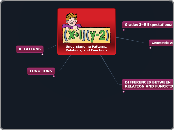MAT.126
1.4-1.5
1.5 Infinite Limits
Find and sketch the vertical asymptotes of the graph of a function
If f(x) approaches infinity (or negative infinity) as x approaches c from the right or the left, then the line x=c is a vertical asymptote of the graph of f.
Subtopic
Theorem 1.14
Vertical Asymptotes
Let f and g be continuous on an open interval containing c. If f(c) is not zero, g(c) is zero, and there exists an open interval containing c such that g(x) is not 0 for all x not c in the interval, then the graph of the function given by
h(x) = f(x) / g(x)
has a vertical asymptote at x=c.
Determine infinite limits from the left and from the right
Let f be a function that is defined at every real number in some open interval containing c (except possibly at c itself).
The statement the limit of f(x) as x approaches c equals positive infinity means that for each M>0 there exists a delta>0 such that f(x)>M whenever 0<|x-c|<delta.
The statement the limit of f(x) as x approaches c equals negative infinity means that for each N<0 there exists a delta>0 such that f(x)<N whenever 0<|x-c|<delta.
To define the infinite limit from the left, replace 0<|x-c|<delta by c-delta<x<c.
To define the infinite limit from the right, replace 0<|x-c|<delta by c<x<c+delta.
1.4 Continuity and One-Sided Limits
Understand and use the Intermediate Value Theorem
Theorem 1.13
Intermediate Value Theorem
If f is continuous on the closed interval [a,b], f(a) is not equal to f(b), and k is any number between f(a) and f(b), then there is at least one number c in [a,b] such that f(c)=k.
The method of bisection depends on the intermediate value theorem and therefore on the continuity of polynomials (and other functions).
This is an example of an existence theorem, a theorem that states that something exists but does not provide a method for finding that which does exit.
Use properties of continuity
Theorem 1.12
Continuity of a Composite Function
Functions Continuous At Every Point in Their Domain
Polynomial
Rational
Radical
Trigonometric
Theorem 1.11
Properties of Continuity
See your text, p. 75
Determine one-sided limits and continuity on a closed interval
Continuity on a Closed Interval
A function f is continuous on the closed interval [a,b] if it is continuous on the open interval (a,b) and the limit from the right of f(x) as x approaches a is equal to f(a) and the limit from the left of f(x) as x approaches b is equal to f(b).
The function f is continuous from the right at a and continuous from the left at b.
Theorem 1.10
The Existence of a Limit
Let f be a function and let c and L be real numbers. The limit of f(x) as x approaches c is L if and only if the limit from the left of f(x) as x approaches c is L and the limit from the right of f(x) as x approaches c is L.
One-sided Limits
Limit from the left
Also called a left-hand limit.
Refers to a limit where x approaches c only from values less than c (to the left of c on a number line or on the x-axis).
Limit from the right
Also called a right-hand limit.
Refers to a limit where x approaches c only from values greater than c (to the right of c on a number line or on the x-axis).
Determine continuity at a point and continuity on an open interval
Discontinuities
Consider a function f, defined on an open interval I containing c (except possibly at c). This function is said to be discontinuous at c if any one of the following are true:
The function f is not defined at x=c.The limit of f(x) does not exist at x=c.The limit of f(x) exists at x=c, but it is not equal to f(c).Nonremovable
A discontinuity at c is called nonremovable if f cannot be made continuous by appropriately defining (or redefining) f(c).
Removable
A discontinuity at c is called removable if f can be made continuous by appropriately defining (or redefining) f(c).
Continuity: Formal
On an Open Interval
A function is continuous on an open interval (a,b) if it is continuous at each point in the interval.
A function that is continuous on the entire real line is everywhere continuous.
At a Point
A function f is continuous at c if the following three conditions are met.
1. f(c) is defined.
2. The limit of f(x) as x appraches c exists.
3. The function value and the limit value are equal.
Continuity: Informal
To say that a function f is continuous at x=c means that there is no interruption in the graph of f at c.
That is, its graph is unbroken at c and there are no holes, jumps, or gaps.








